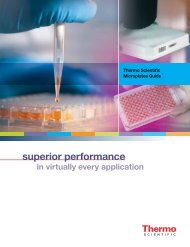PeloBiotech
Create successful ePaper yourself
Turn your PDF publications into a flip-book with our unique Google optimized e-Paper software.
www.pelobiotech.com<br />
You can also check out our Heart slices for toxicology, arrythmia related work which is more translationally relevant. You<br />
can read more about the use of heart slices for research in this article here.<br />
Brain<br />
Apart from isolated and iPS derived astrocytes, Schwann cell like cells, microglia, oligodendrocytes, sensory neurons,<br />
cortical neurons, dopamergic neurons we also isolate endothelial<br />
cells, glioblastomas, pericytes, neuron precursor cells from different<br />
regions of the heart and from various species. Isolated and induced<br />
pluripotent stem (iPS) cell-derived neural cell types, such as<br />
astrocytes, Schwann cell-like cells, microglia, oligodendrocytes,<br />
sensory neurons, cortical neurons, and dopaminergic neurons, serve<br />
as invaluable tools across a spectrum of studies and applications.<br />
Astrocytes, Schwann cell-like cells, microglia, and oligodendrocytes<br />
play crucial roles in various aspects of neuroscience research.<br />
Astrocytes, for instance, are involved in the regulation of cerebral blood<br />
flow, maintenance of synaptic environments, and modulation of<br />
synapse formation and synaptic transmission. They are also implicated in the glymphatic system's ability to eliminate waste<br />
in the brain and are essential for the maintenance of brain homeostasis and neuronal protection. Furthermore, astrocytes<br />
are involved in regulating neuronal synaptogenesis, maintaining blood-brain barrier integrity, and recycling<br />
neurotransmitters. Additionally, they have been shown to mediate analogous memory in a multi-layer neuron-astrocyte<br />
network, and targeting astrocytic function may protect against brain injury induced by blood-brain barrier disruption.<br />
Schwann cell-like cells have been studied for their morphological, transcriptional, and functional differences from mouse<br />
astrocytes, and they play key roles in supporting the central nervous system structure, regulating synaptic functions, and<br />
maintaining brain homeostasis. Microglia, on the other hand, have been found to regulate synapses, neuronal circuits, and<br />
behavior, and they are thought to play a pivotal role in coupling neural activity and cerebral blood flow. Oligodendrocytes,<br />
which are responsible for producing myelin in the central nervous system, have been implicated in the regulation of neuronal<br />
excitability, synaptic transmission, plasticity, and in higher cognitive functions, including the initiation, maintenance, and<br />
consolidation of memories.<br />
Additionally, isolated endothelial cells, glioblastomas, pericytes, and neuron precursor cells from various brain regions<br />
offer insights into angiogenesis, brain tumors, blood-brain barrier function, and neurogenesis, respectively. These diverse<br />
neural cell types facilitate a broad range of studies, including disease modeling, drug screening, neurotoxicity testing, and<br />
elucidating fundamental mechanisms underlying neurological and neurodegenerative disorders.<br />
We also offer brain tissue slices Brain slices, including brain and root ganglionic slices, are valuable tools in neuroscience<br />
research due to their ability to provide a controlled and accessible model for studying various aspects of neuroscience.<br />
Brain slices have been widely used to study neuronal differentiation, cell differentiation, and synaptic transmission. They<br />
have also been utilized to model neurodegenerative proteinopathies and to enhance the quality of acute slice preparations,<br />
particularly for electrophysiology studies.<br />
Brain slices have been instrumental in profiling sequential sections with multiplex staining, which benefits research in life<br />
sciences. Furthermore, brain slice preparations have been validated for enhancing neuronal preservation and overall brain<br />
slice viability, making them essential for studying metabolic changes and facilitating experimentation on age-related<br />
disorders. Moreover, root ganglionic slices, such as dorsal root ganglion neurons, have been used to study neuronal<br />
connectivity, synaptic transmission, and plasticity, as well as to perform whole-cell patch-clamp recordings, allowing<br />
precise measurement of cellular and synaptic properties.<br />
The dorsal root ganglion has been identified as a novel neuromodulatory target for evoking strong and reproducible<br />
motor responses in chronic motor complete spinal cord injury. Studies have been conducted on the trigeminal ganglion<br />
morphology in human fetuses, and the trigeminal ganglion has been studied for its potential in treating trigeminal<br />
neuralgia.<br />
14
















